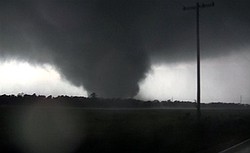Tornado death toll climbs
ASSOCIATED PRESS
This frame grab from video shows a massive tornado on Sunday, May 22, 2011, outside Joplin, Mo. The tornado tore a 6-mile path across southwestern Missouri killing at least 89 people as it slammed into the city of Joplin, ripping into a hospital, crushing cars like soda cans and leaving a forest of splintered tree trunks behind where entire neighborhoods once stood.
It was the deadliest single twister in nearly 60 years
Associated Press
JOPLIN, Mo.
Rescue crews dug through piles of splintered houses and crushed cars Monday in a search for victims of a half-mile-wide tornado that blasted much of this Missouri town off the map and slammed straight into its hospital.
At least 116 people died, making it the nation’s deadliest single tornado in nearly 60 years and the second major tornado disaster in a month. An undetermined number of people were hurt.
Authorities feared the toll could rise as the full scope of the destruction comes into view: House after house reduced to slabs, cars crushed like soda cans, shaken residents roaming streets in search of missing family members. And the danger was by no means over. Fires from gas leaks burned across town, and more violent weather loomed, including the threat of hail, high winds and even more tornadoes.
At daybreak, the city’s south side emerged from darkness as a barren, smoky wasteland.
“I’ve never seen such devastation — just block upon block upon block of homes just completely gone,” said former state legislator Gary Burton, who showed up to help at a volunteer center at Missouri Southern State University.
It was the nation’s deadliest tornado since a June 1953 twister in Flint, Mich., and authorities were prepared to find more bodies in the rubble throughout Joplin, a gritty, blue- collar town of 50,000 people about 160 miles south of Kansas City.
Despite the grim outlook, Gov. Jay Nixon said he was “optimistic that there are still lives out there to be saved.”
Though many residents had 10 to 17 minutes of warning, rain and hail may have drowned out the sirens.
Larry Bruffy said he heard the first warning but looked out from his garage and saw nothing. “Five minutes later, the second warning went off,” he said. “By the time we tried to get under the house, it already went over us.”
As rescuers toiled in the debris, a strong thunderstorm lashed the crippled city. Rescue crews had to move gingerly around downed power lines and jagged chunks of debris as they hunted for victims and hoped for survivors. Fires, gas fumes and unstable buildings posed constant threats.
Teams of searchers fanned out in waves across several square miles. Many of the groups included specially trained dogs. The teams went door to door, making quick checks of property that in many places had been stripped to its foundations or had its walls collapse.
National Weather Service Director Jack Hayes said the storm was given a preliminary label as an EF4 — the second-highest rating given to twisters. The rating is assigned to storms based on the damage they cause. Hayes said the storm had winds of 190 to 198 mph. At times, it was three-quarters of a mile wide.
Some of the most- startling damage was at St. John’s Regional Medical Center, where staff had only moments to hustle their patients into the hallway. Five people died there, although it was not clear if they were patients or staff members.
The storm blew out hundreds of windows and caused damage so extensive that doctors had to abandon the hospital after the twister had passed. A crumpled helicopter lay on its side in the parking lot near a single twisted mass of metal that used to be cars.
Forecasters said severe weather would probably persist all week. Arkansas, Kansas, Missouri and Oklahoma could see tornadoes through today, and the bad weather could reach the East Coast by Friday.
 43
43

